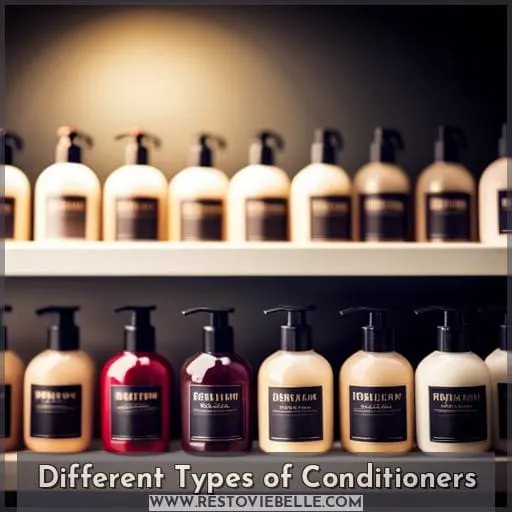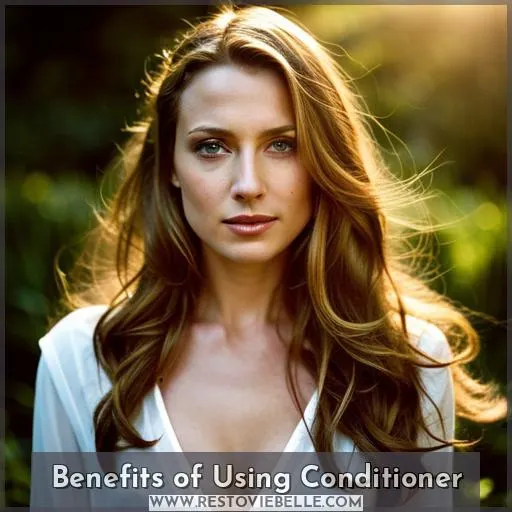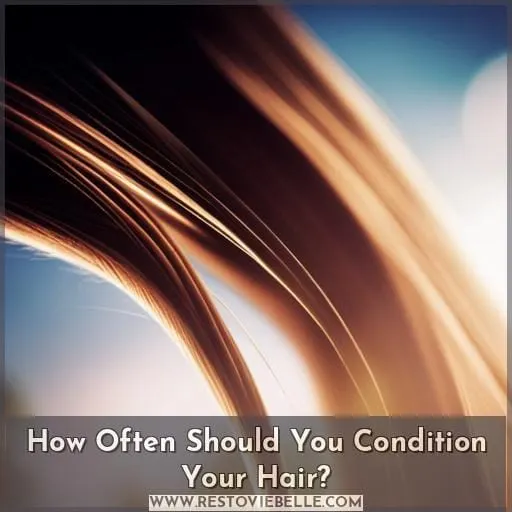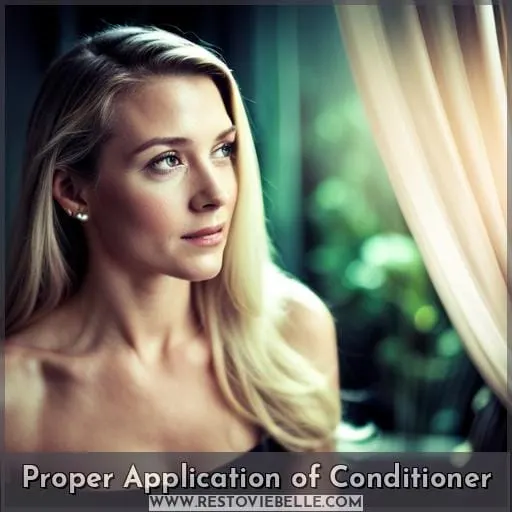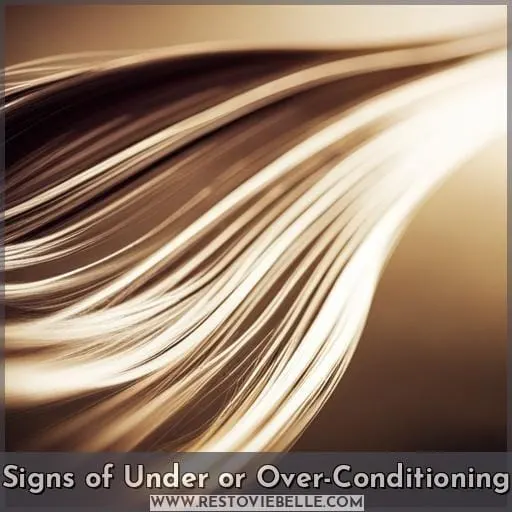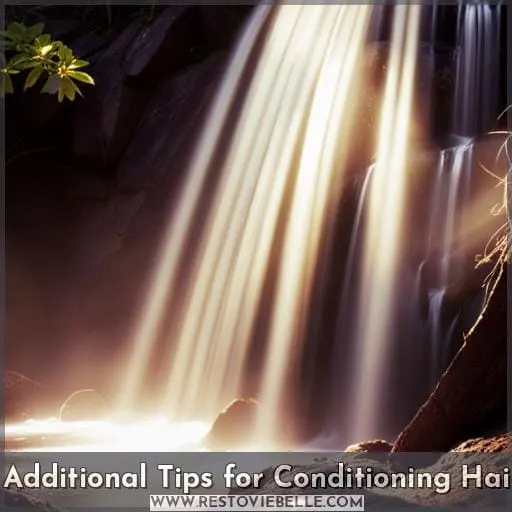This site is supported by our readers. We may earn a commission, at no cost to you, if you purchase through links.
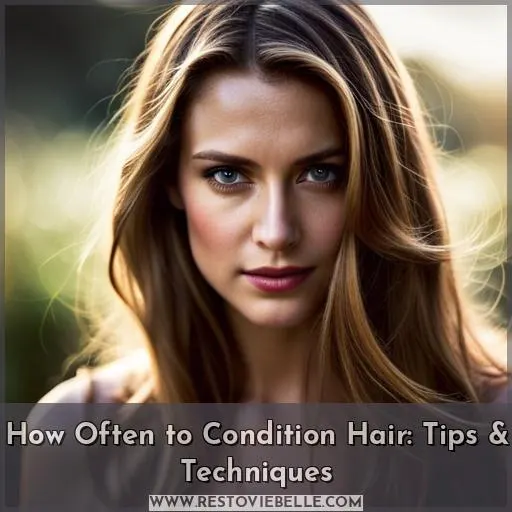 Ever wondered how often you should condition your hair? The frequency of conditioning plays a crucial role in achieving soft, manageable locks. But with different types of conditioners and varying hair needs, finding the right balance can be tricky.
Ever wondered how often you should condition your hair? The frequency of conditioning plays a crucial role in achieving soft, manageable locks. But with different types of conditioners and varying hair needs, finding the right balance can be tricky.
In this article, we’ll explore tips and techniques to help you determine how often to condition your hair based on your unique hair type and the type of conditioner you use.
Table Of Contents
- Key Takeaways
- Different Types of Conditioners
- Benefits of Using Conditioner
- How Often Should You Condition Your Hair?
- Proper Application of Conditioner
- Signs of Under or Over-Conditioning
- Additional Tips for Conditioning Hai
- Frequently Asked Questions (FAQs)
- Can I use a leave-in conditioner instead of a rinse-out conditioner?
- Is it necessary to use a deep conditioner if my hair is not damaged or dry?
- Can I use a cleansing conditioner every day?
- How long should I leave a deep conditioner on my hair?
- Can I use different types of conditioners on different parts of my hair (e.g., rinse-out on the roots and leave-in on the ends)?
- Conclusion
Key Takeaways
- Fine hair should be conditioned every 2-3 days or as needed, focusing on the ends.
- Curly hair should be conditioned every 2-3 days or more frequently to combat dryness and frizz.
- Dry hair should be conditioned every time you wash for extra moisture.
- Damaged or bleached hair should be conditioned at least twice a week with a deep conditioner.
Different Types of Conditioners
When it comes to conditioning your hair, there are different types of conditioners that serve specific purposes.
A rinse-out conditioner is meant to be applied after shampooing and rinsed out after a minute or two.
Leave-in conditioners are designed to be left in the hair until the next wash, while deep conditioners should be left on for 30 minutes or more.
Lastly, cleansing conditioners both clean and condition the hair, eliminating the need for a separate shampoo.
Rinse-out Conditioner
You should apply a rinse-out conditioner after shampooing your hair.
Benefits of rinse-out conditioner include:
- Moisturizing
- Detangling
- Adding shine to the hair
To use it properly, apply an adequate amount and distribute it evenly through your hair.
Use rinse-out conditioner a few times per week for optimal results.
Leave-in Conditioner
Continuing the discussion on different types of conditioners, let’s explore the benefits and proper usage of leave-in conditioner.
This type of conditioner is meant to be left in your hair until the next wash and can provide numerous benefits for your hair health.
Deep Conditioner
For deep conditioning your hair, choose a heavy-duty conditioner that’s designed to repair and hydrate very damaged or dry hair.
Deep conditioners should be used every month or two for optimal benefits in repairing hair damage and improving overall hair health.
- Choose a heavy-duty conditioner.
- Designed to repair and hydrate damaged or dry hair.
- Use every month or two for best results in repairing damage and improving overall hair health.
Cleansing Conditioner
Moving on to the next type of conditioner, let’s talk about cleansing conditioner.
This unique product both cleanses and conditions hair, eliminating the need for a separate shampoo.
It’s lighter than other conditioners and can be used as often as shampoo.
Benefits of Using Conditioner
Using conditioner regularly offers numerous benefits for your hair.
It helps to moisturize and hydrate your strands, making them softer, smoother, and more manageable.
Additionally, conditioner can help repair damaged hair by nourishing it with essential nutrients and proteins.
Frequency of conditioning
To maintain healthy and nourished hair, it’s important to condition your hair regularly.
- Rinse-out conditioner: Use a few times per week after shampooing.
- Leave-in conditioner: Apply once a week or more for curly, dry, or damaged hair.
- Deep conditioner: Apply every month or two for very damaged or dry hair.
- Cleansing conditioner: Can be used as often as shampoo to cleanse and condition simultaneously.
Conditioner helps moisturize and repair your hair, leaving it soft and manageable while also preventing breakage and frizz.
- Clarifying the scalp (for oily roots)
- Deep conditioning (for dry/damaged strands)
- Co-washing (for curly/frizzy textures)
- Leave-in treatments (to provide ongoing moisture between washes)
It’s essential to choose the right type of product based on your specific requirements.
For fine-haired individuals who want lightweight hydration without weighing down their locks, opt for rinse-out formulas applied only at the ends of the hair shafts.
If you have an oily scalp but still need some moisture in your ends without adding extra grease near the roots, use a clarifying formula that focuses on cleansing rather than heavy conditioning properties.
Dry or damaged tresses can benefit from deep-conditioning treatments that penetrate deeply into each strand with intense hydrating ingredients like argan oil.
Curly-haired individuals should invest in moisturizing products designed specifically for their texture since these will help define curls while minimizing frizz caused by lackluster hydration levels within individual strands themselves instead outside factors such humidity changes affecting overall volume control throughout any given day!
Ultimately there isn’t one-size-fits-all answer when determining how frequently someone should apply this beauty staple; however weekly application tends work well most people seeking optimal results maintaining their desired look all year long no matter what hair type they possess.
Choosing the right conditioner
To choose the right conditioner for your hair, consider its specific needs and use a formula that suits it best.
For dry hair, opt for a deep conditioner that moisturizes and repairs damage.
If you have oily hair, go for a clarifying conditioner to remove excess oil.
Curly hair benefits from a moisturizing conditioner to define curls and prevent frizz.
Proper application techniques
Apply conditioner to your hair after shampooing, ensuring even distribution from the mid-lengths to the ends. This technique helps detangle hair and provides moisture where it’s needed most.
For deep conditioning, leave the conditioner on for a few minutes before rinsing.
Avoid applying conditioner directly to oily roots for optimal results.
How Often Should You Condition Your Hair?
You should condition your hair every time you wash it to maintain its moisture and strength.
Here’s how often you should condition based on different hair types:
- Fine Hair: Condition every 2-3 days or as needed, focusing on the ends to avoid weighing down your hair.
- Curly Hair: Condition every 2-3 days or more frequently if needed, as curly hair tends to be drier and prone to frizz.
- Dry Hair: Condition every time you wash your hair, as dryness requires extra moisture and hydration.
- Damaged/Bleached Hair: Condition at least twice a week with a deep conditioner that helps repair damage and restore moisture.
Proper Application of Conditioner
When it comes to properly applying conditioner, there are three key points to consider:
- The amount of conditioner to use.
- The distribution of conditioner throughout your hair.
- The duration of the conditioning treatment.
Using too much or too little can have different effects on your hair’s health and appearance. Ensuring even distribution from mid-lengths to ends is crucial for maximum benefits. Lastly, leaving in the conditioner for an appropriate amount of time allows it enough time to work its magic on your strands.
Amount of Conditioner to Use
When conditioning your hair, it’s important to use the appropriate amount of conditioner for optimal results.
- Apply a small amount of conditioner, about the size of a coin, to the ends of your hair.
- Avoid applying it directly on the roots to prevent greasiness.
- If you have fine or oily hair, using a leave-in conditioner can be beneficial in avoiding over-conditioning.
Distribution of Conditioner
To ensure effective conditioning, evenly distribute the conditioner throughout your hair, focusing on the mid-lengths and ends.
Start by applying to the ends first and then work your way up towards the roots.
Avoid applying directly to the scalp or roots as this can lead to greasiness.
Duration of Conditioning Treatment
For optimal results, leave the conditioner in your hair for the recommended duration to ensure proper moisturization and repair.
Depending on the type of conditioner you’re using, this can range from 10 minutes to overnight. Follow the instructions on the product label for best results and give your hair enough time to absorb all of its nourishing benefits.
Signs of Under or Over-Conditioning
Now that you know how to properly apply conditioner, it’s important to be aware of the signs of under or over-conditioning. Understanding these signs will help you maintain a healthy balance and ensure your hair is getting the right amount of moisture.
If your hair feels dry, brittle, and lacks shine even after conditioning, it could be a sign that you’re under-conditioning.
On the other hand, if your hair feels heavy or greasy shortly after washing and conditioning, this may indicate over-conditioning.
Different factors like climate conditions and individual preferences can affect how often one should condition their specific type of hair, so pay attention to how your locks respond to different routines in order for them remain strong, silky, and lustrous.
Adjustments in frequency or type of conditioner used may be necessary until you find what works best for maintaining balanced hydration levels.
Additional Tips for Conditioning Hai
If you want to keep your hair healthy and well-conditioned, here are some additional tips for conditioning your hair:
- Use a leave-in conditioner on dry hair to help detangle and add moisture.
- Apply conditioner to the mid-shaft to ends of your hair, avoiding the roots.
- Rinse conditioner out completely.
Using a leave-in conditioner can provide extra benefits such as improved detangling and increased moisture retention.
When applying regular rinse-out conditioners, focus on applying them from the mid-lengths of your hair towards the ends while avoiding direct application at the roots.
Lastly, make sure you rinse out all of the conditioner thoroughly after leaving it in for an appropriate amount of time according to product instructions or personal preference.
These simple techniques will help ensure that your conditioning routine effectively nourishes and protects both your strands and scalp.
Frequently Asked Questions (FAQs)
Can I use a leave-in conditioner instead of a rinse-out conditioner?
Yes, you can use a leave-in conditioner instead of a rinse-out conditioner.
Leave-in conditioners are designed to moisturize and repair hair between washes, making them ideal for those with curly, dry, or damaged hair.
Is it necessary to use a deep conditioner if my hair is not damaged or dry?
Using a deep conditioner, even if your hair isn’t damaged or dry, can be like adding fuel to the fire. It’s unnecessary and could weigh down your strands. Stick to a regular conditioner for healthy locks.
Can I use a cleansing conditioner every day?
Yes, you can use a cleansing conditioner every day. It cleans and conditions your hair in one step, eliminating the need for a separate shampoo.
How long should I leave a deep conditioner on my hair?
Deep conditioners work their magic in 30 minutes or more.
The longer you leave it on, the better the results.
It’s like giving your hair a spa treatment, nourishing and hydrating for that luscious look.
Can I use different types of conditioners on different parts of my hair (e.g., rinse-out on the roots and leave-in on the ends)?
Yes, you can use different types of conditioners on different parts of your hair.
For example, you can use a rinse-out conditioner on the roots and a leave-in conditioner on the ends to address specific needs.
Conclusion
To achieve soft, manageable locks, it’s important to find the right balance when conditioning your hair.
Different types of conditioners, such as rinse-out, leave-in, deep, and cleansing conditioners, offer various benefits for your unique hair type.
The frequency of conditioning depends on your hair’s needs and the type of conditioner you use.
Proper application techniques, including the amount of conditioner to use, distribution, and duration of the treatment, also play a role in achieving nourished tresses.
Pay attention to signs of under or over-conditioning to maintain the health of your hair.
